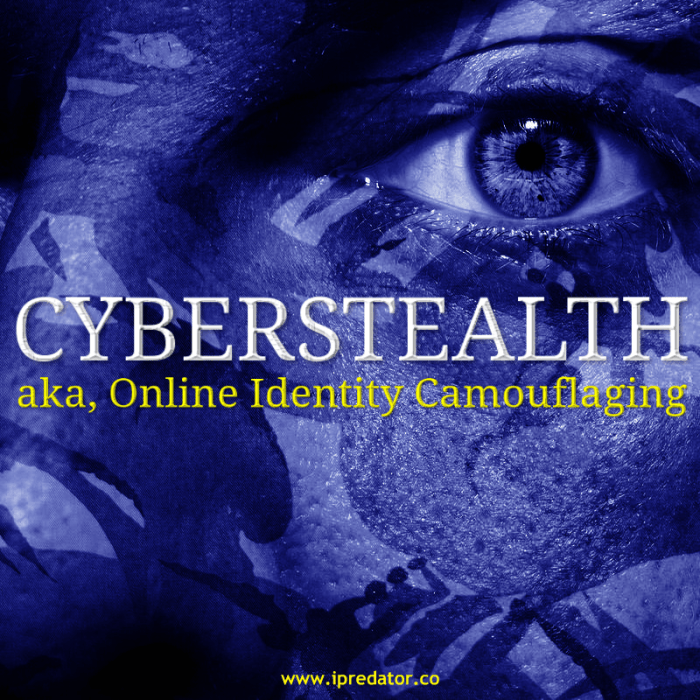Cyberstealth
Online Deception & iPredator Digital Cloaking
Information and Communications Technology (ICT) and the Information Age have created a new dimension leading to an entirely new population of humanity engaged in malevolent, harmful and deceptive practices. ICT and cyberspace are not tools used by the classic sociopath, deviant, narcissist or criminal, but a new generation called iPredators. These online assailants will be permanent fixtures to humanity for centuries to follow. In order to effectively educate, evaluate, investigate or advise any ICT user on internet safety, whether they are a child, adult, group or business, it is paramount to grasp the basic concepts and terms vital to all ICT users. The two terms important to be familiar with are iPredator & Cyberstealth. For it is in cyberspace & the internet, using ICT, that vast majority of iPredators develop, activate and institute Cyberstealth.
The Information Age is a societal paradigm and period beginning in the last quarter of the 20th century and presently thriving in the second decade of the 21st century. The Information Age represents the evolution, emergence, consumption of and reliance upon Information and Communications Technology (ICT). In a mere four decades, ICT and its importance to humanity have led many to surmise that the planet and its human inhabitants are amidst an Information Revolution. Mobile device technology, telecommunications, social media & cyberspace are just a few examples of humanities’ newest communication channels. In all these arenas, they deal with the new frontier of how humankind obtains exchanges and disseminates information.
Unlike human predators prior to the Information Age, iPredators rely on the multitude of benefits offered by Information and Communications Technology (ICT.) These assistances include exchange of information over long distances, rapidity of information exchanged and the infinite access to data available. Malevolent in intent, iPredators rely on their capacity to deceive others using ICT in the abstract and artificial electronic universe known as cyberspace. Therefore, as the internet naturally offers all ICT users anonymity if they decide, iPredators actively design online profiles and diversionary tactics to remain undetected and untraceable.
Hidden in cyberspace, and through ICT, they contemplate the benefits and detriments, proceed, and then continue a path where their cognitive and perceptual processes are focused upon directly or indirectly harming others. For those who cross this proverbial bridge, they enter a world where their choices are increasingly governed by criminal, deviant, immoral and maladaptive processes. Although it is assumed all humanity, has residing deep in their psyche, the potential & Dark Psychology for behaving in harmful and malevolent ways they rarely or never activate, ICT and cyberspace offers a direct connection and psychological route to the dark side. Just as ICT and cyberspace is incredibly pro-social and beneficial to humanity, these same technological advancements can lead humanity to diabolical and sinister endeavors.

Cyberstealth
Cyberstealth is a concept formulated along with iPredator and is a term used to define a method and/or strategy by which iPredators use Information and Communications Technology (ICT) , if they so choose, to establish and sustain complete anonymity while they troll and stalk a target. Cyberstealth is a methodology entrenched in Information Age Deception or also called cyber deception. Given the Internet inherently affords everyone anonymity, Cyberstealth used by iPredators ranges from negligible to extraordinarily complex and multi-faceted. The rationale for using “stealth” in the suffix of this term serves to remind ICT users the primary intent fueling iPredators. This intent is to hide their identity by designing false online profiles, identities, covert tactics and methods to ensure their identities remain concealed reducing their probability of identification, apprehension and punishment.
Unlike classic deception used by traditional criminals and deviants, Information Age Deception completely relies on the anonymity and “veil of invisibility” available to all ICT users. The primary difference between Information Age Deception and Cyberstealth are the activities iPredators and ICT users engage in. In this writer’s construct, Cyberstealth is reserved for iPredators who actively plan a strategy that have criminal, deviant and harmful implications to targeted victims. Information Age Deception includes all forms of Cyberstealth, but also includes deceptive practices that do not have elements of crime, defiance or harm against others. An example of Information Age Deception, not included in Cyberstealth, would be a young man who joins an online dating service and publishes in his dating profile that he if 6’0 feet tall when he is really 5’9.
Online Deception does not require an ICT user to engage in nefarious, deviant or malevolent activities. Although all forms of deception are problematic, Information Age Deception can be as subtle of what many call a “white lie.” Another difference is when iPredators use Cyberstealth to hide their identity from victims. In general, iPredators use Cyberstealth when their actions involve illegal activities and hiding their identity is paramount to reduce being identified, apprehended and prosecuted. ICT users who evaluate their odds of being identified, develop tactics and strategies to minimize identification are motivated by criminal, deviant & harmful causes are iPredators using Cyberstealth.
As the Internet naturally offers all ICT users anonymity if they decide, iPredators actively design online profiles and diversionary tactics to remain undetected and untraceable. Cyberstealth is a covert method by which iPredators are able to establish and sustain complete anonymity while they engage in ICT activities planning their next assault, investigating innovative surveillance technologies or researching the social profiles of their next target. Concurrent with the concept of Cyberstealth is IVI or iPredator Victim Intuition. By using Cyberstealth, an iPredator’s IVI is the aptitude to sense a target’s online vulnerabilities, weaknesses and technological limitations increasing their success with minimal ramifications.
iPredators rely on the multitude of benefits offered by ICT. These assistances include exchange of information over long distances, rapidity of information exchanged and the infinite access to data available. Malevolent in intent, iPredators rely on their capacity to deceive others in the abstract electronic universe known as cyberspace. The iPredator practices Cyberstealth using multiple covert strategies. In fact, the third criteria used to define an iPredator includes a general understanding of Cyberstealth used to engage in criminal or deviant acts or to profile, identify, locate, stalk and engage a target. Also lying upon a continuum of expertise, iPredators are assessed as being advanced in their Cyberstealth practices as opposed to a haphazard approach of targeting a victim without attempting to hide their identity.
Often, cyberbullies, ex-partners, ex-employees, angry or self-righteous online users, Internet trolls, organized groups with political, religious, moralistic causes, child molesters, pedophiles and highly narcissistic online users do not attempt to hide their identities. Cyberstealth is a strategy reserved for iPredators who seek to hide their identities online.

Cyberstealth Plans Cloaked Identification!
As stated above, Cyberstealth is a concept formulated along with iPredator used to define a method and/or strategies by which iPredators devise tactics to establish and sustain complete anonymity while they troll and stalk an online target. In addition to a stratagem, Cyberstealth is a reality of ICT that humanity often fails to fathom, leading some ICT users to become high probability targets. Cyberstealth is a learned behavior that becomes more advanced with practice, trial and error and experimentation.
For some iPredators, they seek the advice and consultation of other iPredators to hone their skills. In the realm of nefarious motivated “hacking,” some iPredators actively seek insight from other hackers to advance their knowledge base. Although “hackers” tend to be considered by the general mainstream as villainous, there are two distinct groups defined by their motivations. “Black Hat Hackers” engage in nefarious and malevolent online activities. “White Hat Hackers” are ICT security experts.
“Given the Internet and ICT inherently affords everyone’s anonymity, Cyberstealth used by iPredators range from negligible to highly complex and multi-faceted.” Michael Nuccitelli, Psy.D. (2011)
Like IVI, Cyberstealth is a learned behavior that becomes more advanced through trial and error, experimentation, consultation with other online users who engage in malevolent or nefarious activities and investigation of ICT products and services focused on hiding an ICT user’s identity and the ability to engage in anonymous surveillance. In addition to being a learned behavior, Cyberstealth may also include an inherited aptitude, capacity or skill set just as some people have special skills even though they are new to a craft. The rationale for using “stealth” in the suffix of Cyberstealth, serves to remind ICT users the primary intent fueling many iPredators. This motivation is to hide their identity by designing fictive online profiles, identities, tactics and methods to ensure their identities remain concealed reducing recognition and castigation. Therefore, as the Internet and ICT naturally offers all users’ anonymity if they decide, iPredators actively design profiles and diversionary tactics to remain undetected and untraceable.
Stealth: According to the Merriam Webster dictionary, Stealth is “the act or action of proceeding furtively, secretly, or imperceptibly.” Stealth as an adjective is, “intended not to attract attention.” The American Heritage dictionary defines Stealth as “the act of moving, proceeding or acting in a covert way and the quality or characteristic of being furtive or covert.”

Cybercrime, Identity Theft & Fraud
Cyberstealth is a covert method by which iPredators can establish and sustain complete anonymity while they engage in ICT activities planning their next assault, investigating innovative surveillance technologies or researching the social profiles of their next target. When profiling or investigating an iPredator, their level of Cyberstealth complexity, digital footprint, victim preferences, ICT skills and behavioral patterns are used to identify who they are.
iPredator is a global concept that includes children, adults and organized groups who directly or indirectly use ICT to harm or exploit others. The goal of the United States and all industrialized nations is to stop the growth of iPredators by educating its citizens on their tactics and strategies. From a profiling and investigation standpoint, assessment of an iPredator’s Cyberstealth tactics and Digital Footprint can assist authorities in their profiling, identification and apprehension. Just as classic criminal profiles have signatures used to apprehend them, iPredators have digital signatures as well.
The importance of ICT and the Internet to humankind is different to everyone and as unique as a fingerprint. For some, ICT and the Internet are nothing more than tools of convenience for conducting mundane tasks. For others, their social, scholastic, business and/or financial affairs disclosed online are crucial to their life functioning, self-esteem, self-worth, success and perceptual world.
As ICT, social media, virtual reality and the Information Age rapidly expand, becoming integral to humanities daily activities, understanding the basic tenets of these new dimensions are preponderant. In 2011, the Internet celebrated its 20th birthday. In 2013, most humanity continues to fail in understanding the golden rule of unfamiliar territory exploration. What always comes with opportunity and new frontiers are elements unknown and potentially dangerous. It is these unknown and dangerous elements, lurking within cyberspace, which ICT users and their loved ones must be vigilant about. Technological advancements have changed the way humanity interacts, exchanges and accesses information. Smartphones, mobile devices and social media are the latest in a succession of advancements growing at a feverish pace.
Deception has been part of the human experience since the beginning of civilization. Not only practiced by humans, but deception is also a tool used by most living organisms. Other than humans, living organisms who use deception do so for the instinctual needs of survival & procreation. From a survival standpoint, both the predator and prey use deception to camouflage themselves. To hide from predators and prevent attack, many living organisms use camouflage to disguise themselves reducing their chances of being identified by predators. When the organism is a predator, deception is used to hide their identity increasing their probability the prey item will be unaware and vulnerable by an attack.
Regarding procreation, all living organisms use deception, usually the male of the species, to present themselves as strong, healthy and more attractive than they are when not seeking to procreate. When seeking a mate, the male peacock will unfurl and spread his beautiful multi-colored tail feathers to send the message to females he is healthy and the best choice over his male competitors. Humans use deception for survival and procreation, but also for nefarious, deviant and dysfunctional reasons. From an interpersonal standpoint, deception and lying to others are frowned upon and rooted in hidden agendas and foul play. From a macroscopic perspective, most forms of deception are not considered acceptable or ethical. When applied to interpersonal communication, deception is called lying. When a person engages in frequent lying, they are called a pathological liar. Pathological or patterned lying is highly suggestive that the person suffers from some form of psychiatric illness or perceptual distortion or is engaging in unscrupulous activities.
Society, communities and families are slowly disconnecting and becoming more dependent on Information and Communications Technology. Although this writer remains an optimist, at times the reality of how people treat one another in cyberspace tests his optimistic method of operating. As people spend greater amounts of time and effort engrossed in their social media profiles, online “whatever” accounts and careers, the seeds of Narcissism within everyone is cultivated. Humanity on the individual level is experiencing Cyber Narcissism and learning how Information Age Deception is not only easier, but also more convenient and fruitful. Unfortunately, iPredators are the primary beneficiaries of the societal perceptual trajectory occurring before everyone’s eyes without notice.
Cyberstealth is a concept formulated along with iPredator used to define a method and/or strategies by which iPredators devise tactics to establish and sustain complete anonymity while they troll and stalk an online target. In addition to a stratagem, Cyberstealth is a reality of ICT that humanity often fails to fathom, leading some ICT users to become high probability targets. Cyberstealth is a learned behavior that becomes more advanced with practice, trial and error and experimentation. Most importantly, iPredators rely on their targets to be discouraged, isolated and self-absorbed. The more disconnected a community is, the easier it is for them to succeed in their nefarious and malevolent endeavors.
iPredator Predatory Troll Checklist (IPTC)

Michael Nuccitelli, Psy.D.
Michael Nuccitelli, Psy.D. is a NYS licensed psychologist, cyberpsychology researcher and online safety educator. In 2009, Dr. Nuccitelli finalized his dark side of cyberspace concept called iPredator. Since 2010, he has advised those seeking information about cyberbullying, cyberstalking, cybercriminal minds, internet addiction and his Dark Psychology concept. By day Dr. Nuccitelli is a practicing psychologist, clinical supervisor and owner of MN Psychological Services, PLLC. After work and on the weekends, he volunteers helping online users who have been cyber-attacked. Dr. Nuccitelli’s is always available to interested parties and the media at no cost. This website and everything created by Dr. Nuccitelli is educational, free and public domain.